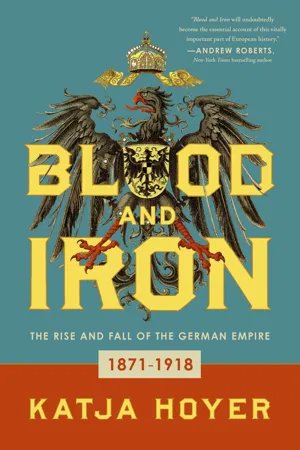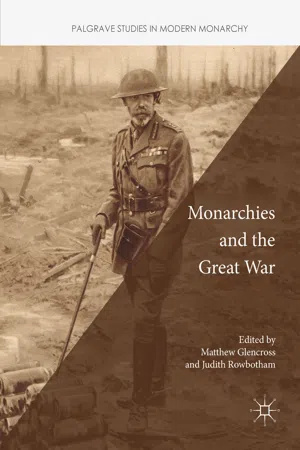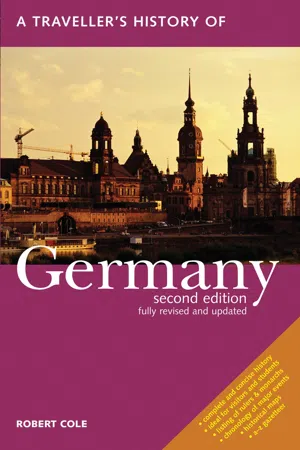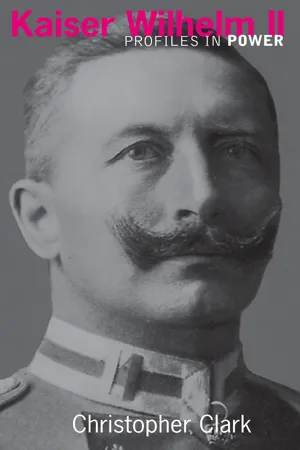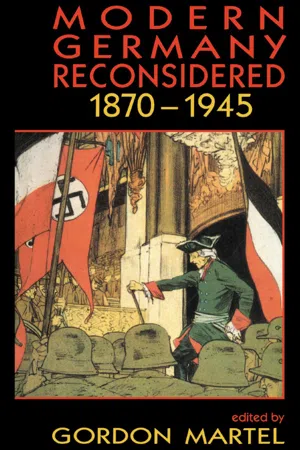History
Wilhelm II
Wilhelm II was the last German Emperor and King of Prussia, ruling from 1888 to 1918. He pursued an aggressive foreign policy, which contributed to the tensions leading to World War I. His reign saw significant social and political changes in Germany, and his leadership style and decisions have been widely debated by historians.
Written by Perlego with AI-assistance
Related key terms
9 Key excerpts on "Wilhelm II"
- eBook - ePub
Blood and Iron
The Rise and Fall of the German Empire
- Katja Hoyer(Author)
- 2021(Publication Date)
- Pegasus Books(Publisher)
WILHELM’S REICH 1890–1914‘The kaiser is like a balloon: if you don’t keep fast hold of the string, you never know where he will be off to.’ Otto von BismarckPersonal Rule or Shadow Emperor?
‘Suprema lex regis voluntas’ – ‘The will of the king is the highest law’ – wrote Wilhelm II in 1891 into the Golden Book of the City of Munich. It is one of many self-aggrandising statements that sum up the young Kaiser’s self-image as ruler perfectly. No longer would Germany be governed by an overbearing old bureaucrat like Bismarck, but a glorious new imperial era was to dawn that would inspire the German people to overcome their differences and find a national focal point in their Kaiser. This ‘policy of consolidation and conciliation’I would become the hallmark of Wilhelm’s early phase of kingship. However, the principles on which it relied were dangerous, not least among them a hostility towards the supposed enemies to German greatness: socialists, democrats and foreign rivals. The young Kaiser built up a glittering facade of imperial pomp in his palaces and castles that deliberately contrasted with the frugal interior of the chancellery in the Wilhelmstrasse. He thus tried to create an image of monarchical power that seemed outdated, even anachronistic to many. By the turn of the century, it would begin to unravel.The period from 1890 to 1914 has often been dubbed ‘Wilhelmine’ and for good reason. Just as Bismarck dominated the first phase of the German Empire from 1871 to 1890, Wilhelm put his own stamp on the period leading up to the First World War, at which point he was sidelined by the military establishment. It seems somewhat ironic that Bismarck had prided himself on protecting the German monarchy from the reduced status seen in other countries such as Britain, Italy or the Netherlands. There, constitutional ties had supposedly turned kings and queens into little more than ‘automatic signing machines’.II Bismarck nevertheless decided to put himself, as chancellor, at the heart of the first German constitution. But Wilhelm had other plans. He wanted no chancellor, parliament or ministers to mitigate his power. As Hans-Ulrich Wehler put it, ‘he tried to be both Chancellor and Emperor in one’.III - eBook - ePub
Crowns and colonies
European monarchies and overseas empires
- Robert Aldrich, Cindy McCreery(Authors)
- 2016(Publication Date)
- Manchester University Press(Publisher)
G. Röhl, Isabel V. Hull and Annika Mombauer have focused on what they have seen as the Kaiser’s ‘personal rule’ or the ‘kingship mechanism.’ 15 On the general question of Germany’s imperial ambitions, Röhl, for example, has argued that global empire was the personal project of the Kaiser. For Röhl, it was ‘the almost overwhelming personal power of Kaiser Wilhelm, who was able to determine the Reich’s policy down to the smallest detail’, which was at the root of ‘the global dimensions of German aims’. 16 For her part, Mombauer has charted the Kaiser’s clumsy role in garnering European support behind Alfred von Waldersee, his candidate for ‘commander-in-chief’ of the multinational force operating in China during the Boxer Rebellion. 17 Correctly, she pointed out that, as Commander-in-Chief, the Kaiser theoretically had enormous latitude in military affairs. 18 Still, for Mombauer, the Kaiser’s role essentially amounted to eroding Germany’s standing abroad by dabbling in symbolic politics and precipitating a foreign-policy crisis from which he then had to retreat. In the accounts of those stressing the Kaiser’s power, the effects of this power were often fraught. Yet it is possible to go further than arguing that the Kaiser was an imperial activist by looking beyond his own sense of his importance to events and paying attention to the judgements of those who surrounded him. Despite Wilhelm II’s own sense of himself as a seriously engaged global military figure, the Kaiser was often shielded from the full weight of his constitutional powers by others who understood his limitations only too well - eBook - ePub
- Matthew Glencross, Judith Rowbotham, Matthew Glencross, Judith Rowbotham(Authors)
- 2018(Publication Date)
- Palgrave Macmillan(Publisher)
© The Author(s) 2018Begin AbstractMonarchies and the Great War Palgrave Studies in Modern Monarchy https://doi.org/10.1007/978-3-319-89515-4_3Matthew Glencross andJudith Rowbotham (eds.)End Abstract3. Crown Prince Rupprecht of Bavaria, the German Command and Kaiser Wilhelm II in 1914–1915
Introduction
Was Wilhelm merely a ‘shadow-Kaiser’, with real power vested in the traditional power structures of Prussia and Germany? Or did he exercise a decisive influence on political outcomes? Such questions have generated intense debate over a long period. The list of scholars who have taken part is a veritable ‘Who’s Who’ of the biggest beasts in the modern German history jungle.1 In essence, there are two main camps. On the one hand, some, like Professor John Röhl, believe that Wilhelm was either bad or mad, a proto-Hitler who led his country to destruction via a quasi-absolutist ‘kingship mechanism’.2 On the other, others believe that he had little real power.3 Within this tradition, one can distinguish between those, like Hans-Ulrich Wehler, whose interest in structures prevents them ascribing much importance to any kind of individual agency; and those, such as Christopher Clark, who maintain that Wilhelm did exercise agency. He operated, however, within a power structure so fluid and complex that it could only be controlled by a statesman of Bismarck’s calibre; since Wilhelm fell far short of that standard, he was unable consistently to exercise the executive prerogatives at his fingertips and to deliver any consistent programme or set of outcomes.This chapter is born out of a view that a gap remains in the existing scholarship. Specifically, although the role of the Kaiser in the outbreak of the First World War, while still contested, has been examined minutely, his involvement in the actual conduct of the war has been less deeply explored. The two best known recent biographies of Wilhelm II are those by Christopher Clark and John Röhl. The former dedicates 39 of his 367 pages to the First World War, compared with 50 to discussion of the Kaiser’s foreign policy role in the run-up to the war from 1909. In his third volume, Röhl spends proportionally even less space on wartime: 78 pages out of 1267, almost the same as he lavishes on Wilhelm’s exile and death. This compares with 128 detailing preparations for war in 1913 and 1914 alone. What work has been done on it tends to take a top-down view, drawing primarily on the evidence of the immediate entourage. - eBook - ePub
- Robert Cole(Author)
- 2014(Publication Date)
- Interlink Books(Publisher)
CHAPTER NINEThe Age of Wilhelm II, 1890-1918Emperor Wilhelm II was bom with a withered left arm. As a growing child, he wore braces, clamps, a medical boot, and was given shock treatments to make the arm grow into normality. Nothing worked. The arm appeared to atrophy, and as portrait photographs make clear, it remained shorter than his right arm his entire life. The deformity may have given him an inferiority complex, contributing to his ‘bully-boy’ expansionism of the pre-1914 era. A theory only; yet Wilhelm pushed with an ‘in your face’ attitude for a German colonial empire, challenged British naval supremacy, and revelled in being Commander-in-Chief of the largest German army in history.Germany After BismarckThe sacking of Otto von Bismarck as Chancellor, pictured in a London Punch cartoon as the emperor ‘dropping the pilot’ of the German ship of state, opened the door to Wilhelm calling the shots as Head of State. And he did for the most part with the support of the system under which Germany functioned in Bismarck’s era: the Prussian aristocracy set the standards for the army, western German industrialists ran the economy, and aristocrats, also mostly western, dominated the imperial bureaucracy.‘THE MOST BRILLIANT FAILURE IN HISTORY’What was he like, the new German emperor, grandson of Queen Victoria of England? He was twenty-nine, full of himself, and in the view of Portuguese diplomat and writer José Maria Eça de Queiroz, a man of many faces. In 1891 he described Wilhelm as, variously, a Soldier King who put changing the guard over all matters of state, a Reform King concerned only with capital and wages, a King by Divine Right ‘haughtily resting his sceptre on the backs of his people,’ a Courtier King, worldly and pompous, and a Modern King, ‘dreaming of a Germany worked entirely by electricity.’ Queiroz opined that what he actually was, or would be, was anyone’s guess. - eBook - ePub
Fighting for Status
Hierarchy and Conflict in World Politics
- Jonathan Renshon(Author)
- 2017(Publication Date)
- Princeton University Press(Publisher)
16The architects of Germany’s world policy were Kaiser Wilhelm II and his chancellors, Bernhard von Bùlow and his successor, Bethmann Hollweg. The kaiser, however, was the undisputed power behind German foreign policy. Article 11 of the German Constitution gave full power to “declare war and conclude peace” to the kaiser (who was also the German emperor and king of Prussia). The only check on his power was the Bundesrat, the German Upper House, which was composed mostly of German princes and nobility, and as such would hardly have considered crossing Wilhelm. Wilhelm also had unilateral authority to declare a state of war in the case of a severe security threat to the Reich, and was in sole possession of the “power to command” (the famous German General Staff was technically only an advisory bureau).17Wilhelm ascended to the throne in 1888, and by 1896 had succeeded in establishing his own brand of personal rule by dismissing any ministers who opposed his plans for a vigorous foreign policy.18 Emblematic of this, the following quote is attributed to him on his ascension to power: “The Foreign Office? Why, I am the Foreign Office!” And in a letter to the prince of Wales, he insisted, “I am the sole master of German policy.”19Because ultimate authority rested with the kaiser, it is worth exploring how he saw the policy of Weltpolitik:As my grandfather did for the Army, so I will, for my Navy, carry on … the work of reorganization so that it may also stand on an equal footing with my armed forces on land and so that through it the German Empire may also be in a position abroad to attain that place which it has not yet reached20Bülow was chancellor (a position appointed by the kaiser) from 1900 to 1909, and a chief architect of Germany’s foreign policy during that period. His description of Germany’s world policy in a speech to the Reichstag summarized it thusly: - eBook - ePub
- Christopher Clark(Author)
- 2013(Publication Date)
- Routledge(Publisher)
Die Post declared that the ‘entire essence’ of the government’s Moroccan policy reflected ‘fearfulness, weakness of character [and] cowardice’:Is Prussia no longer itself? Are we become a nation of women? . . . What has become of the Hohenzollern, from whom sprang once a Great Elector, a Friedrich Wilhelm I, a Frederick the Great, a Kaiser Wilhelm I? The Kaiser appears to be the strongest pillar of French and British policy. . . . Guillaume le timide, le valeureux poltron!78This article did not command unanimous support, indeed it was widely condemned for its irreverence, but similar views were heard within the senior ranks of the military, where there was contemptuous talk of the ‘peace-Kaiser’ who had failed to defend the honour of his fatherland.79 In August 1911, the gifted young officer Erich von Falkenhayn, commander of a Guards regiment and a personal favourite of the Kaiser, observed in a letter to a friend that nothing would change in Germany as long as the Kaiser continued to be ‘determined to avoid the most extreme action’.80 In March of the following year, during the quiet spell that set in after resolution of the Moroccan crisis, he noted that the emperor remained ‘quite determined to maintain peace under any circumstances’, and added regretfully that ‘in his entire milieu there is not one individual who is capable of dissuading him from this decision’.81Wilhelm’s Impact
To what extent can Wilhelm be held responsible for Germany’s drift into deepening isolation during this era? In addressing this question we need to distinguish between the influence he could wield over the policy-making processes of the German government and his influence on the wider international environment within which German policy had to operate. We shall consider each in turn. - eBook - ePub
Modern Germany Reconsidered
1870-1945
- Gordon Martel(Author)
- 2002(Publication Date)
- Routledge(Publisher)
2 Wilhelmine Germany JAMES RETALLACK For 30 of the 45 years since the collapse of Hitler’s regime, questions about the structure and dynamic of the Wilhelmine empire have been crucial in explaining the origins of Nazism. It is difficult to imagine now the outlook of the late 1940s and 1950s when the most important historians in Germany insisted that Hitler had come out of nowhere to ‘dupe’ the German people into supporting his regime. This portrait of Hitler as an aberration, as something unique in German history, was advanced by conservatives in the profession who, for a variety of reasons, could not address the Nazi catastrophe directly. 1 In order to lay a foundation for a closer examination of the major turning points in the historiography of the Second Reich, this chapter will begin with a discussion of the period immediately following the First World War. These turning points include the ‘Fischer controversy’ that emerged in the 1960s, the publication of The German Empire in 1973—an important book by Hans-Ulrich Wehler—and subsequent critiques of the Wehler interpretation, which continue to dominate German historiography today. The second half of the chapter adopts a thematic approach in order to suggest how a unitary view of Wilhelmine Germany has disintegrated in the last fifteen years—and what might follow. Debates to be examined include the role of Wilhelm II, more positive aspects of German society and culture, the importance of regionalism, the (alleged) ascendancy of the bourgeoisie, and the predicament of ‘under-privileged’ groups in society. The chapter concludes with a prognosis for historical writing on Wilhelmine Germany in the 1990s, in effect posing the question: where next for the Kaiserreich? It is perhaps worth hinting at the outset that the reader will find few definitive answers here. New paradigms of historical analysis are emerging only slowly and a consensus about Wilhelmine Germany remains elusive - A. Walter(Author)
- 2020(Publication Date)
- Perlego(Publisher)
After the close of this war he returned to Berlin and spent the remainder of his days in peace, the administration of internal affairs being left largely to his great coadjutor, Prince Bismarck. In connection with Von Moltke, these two, the Iron Emperor and the Iron Chancellor, made Germany the leading power of Europe. In simpleness of life, honesty of character, devotion to duty, love of country, and splendor of achievement, the Emperor William’s life is a study for all youth and all people.G. P. U.Chicago , May 10, 1909.Contents
Chapter PageI Early Life 11II A Hard School 19III Years of Peace 36IV Troublous Times 42V In Trust 49VI The Austro-Prussian War 56VII The Franco-Prussian War 64VIII Sedan 73IX Army Anecdotes 88X Family Life of the Emperor 101XI The Emperor’s Death 112Appendix 128Illustrations
Emperor William First FrontispieceThe cornflower wreaths 22The two Emperors 68The Emperor’s deathbed 116Emperor William First
Chapter I Early Life
King Frederick William Second was still upon the throne of Prussia when his son and successor, afterward Frederick William Third, was married to the lovely Louise of Mecklenburg-Strelitz. The memory of this noble pair is treasured in every Prussian heart, and their self-sacrificing devotion to the people, their benevolence and piety, will serve as a shining example for all time.On the fifteenth of October, 1795, a son was born to them, the future King Frederick William Fourth, and on the twenty-second of March, 1797, the Crown Princess gave birth to a second son, whose name was destined to be inscribed in golden letters in the book of the world’s history. Although a handsome boy, his health was so delicate as to cause his parents much anxiety, and it seems almost like a special dispensation of Providence that he should have lived to an age far beyond that usually allotted to the fate of mortals.On the third of April the christening took place in the Crown Prince’s palace. Chief Councillor of the Consistory Sack stood before the altar, which was ablaze with lighted tapers, and ranged before him in a wide semicircle were the priests, the Crown Prince, and the godparents. Others present were the King and Queen; the widowed Princess Louise, a sister of the Crown Princess and afterward Queen of Hanover; Princes Henry and Ferdinand of Prussia, brothers of Frederick the Great, with their wives; Princes Henry and William, brothers of the Crown Prince; their sister, the Electress of Hesse-Cassel; Prince George of Hesse-Darmstadt, and the hereditary prince Frederick William of Orange. Proxies had been sent by the Czar and Czarina of Russia, Prince William of Nassau, the Landgrave of Hesse-Darmstadt, and the Landgrave of Hesse-Cassel. The principal governess, Countess Voss, handed the child to the King, who held him during the ceremony. He received the names Frederick William Louis, with the understanding that William was the one by which he should be known.- Richard J. Evans(Author)
- 2015(Publication Date)
- Routledge(Publisher)
1Introduction: Wilhelm II’s Germany and the Historians Richard J. EvansI
The ten original essays collected in this book have all been specially written for the occasion and are published here for the first time. The authors are all British historians of the younger generation.1 It is hoped that the contributions in this volume will give some indication of the wealth and diversity of scholarly research now being carried out in Britain on the history of Germany between 1888 and 1918. All the authors have worked extensively on primary sources in German archives. Their essays make use of unpublished documentary material in East and West Germany to cast new light on many aspects of Wilhelmine politics and society, both familiar and unfamiliar. The contributions are arranged by topic along a political continuum starting with problems of government and moving from the right wing through political movements in the middle – peasant populism, political Catholicism, liberalism – to Trade Unionism and Social Democracy, ending with a study of militancy and revolution on the far left. Alternatively, the sequence of essays can be viewed in terms of a descent down the social scale, beginning with the Kaiser and the Chancellor and progressing through the industrialists, administrators and intelligentsia via the urban and rural petty-bourgeoisie to the workers on the shop-floor and down the mines, taking in other social groups such as women and youth en route. In this way, the book as a whole tries to give the reader some impression of the range of political opinions and social groups which existed in the German Empire between the end of the 1880s and the beginning of the 1920s.It is, of course, in no way fortuitous that so many younger historians in Britain – and there are others besides the contributors to this book2 – are now working on the history of Wilhelmine Germany. For in little over a decade, since the middle of the 1960s, the study of German history between 1888 and 1918 has undergone a profound revolution which has made it now one of the most exciting of all historical areas to be working in. The revolution was set off by the publication in 1961 of Fritz Fischer’s book Griffnach der Weltmacht (published in English in 1967 as Germany’s Aims in the First World War). Fischer’s book brought a mass of documentary evidence to light on the vast range and extent of German war aims in 1914—18. The most controversial part of the book was its claim that Germany had not only sought to annex much of Europe and dominate the rest during the war, but that this had also been the intention of Wilhelm II and his advisers for some time before 1914 as well; indeed, they had deliberately launched the war in order to achieve this. Outside Germany these arguments had been familiar to historians for some time. But within the West German historical profession itself they were regarded as little better than treachery to the national cause. Moreover, some of the implications of Fischer’s work were even more disturbing. If Wilhelm II’s Germany deliberately launched a war of European conquest, then Hitler’s ‘Third Reich’ was perhaps not such a unique phenomenon as German historians had previously professed to believe. It was scarcely surprising, therefore, that Fischer’s book aroused a storm of controversy within the German historical profession, particularly since it appeared at a time when the West German Federal Republic was trying hard to establish its credentials as a democratic and peaceful country before a sceptical and mistrustful international audience.3
Index pages curate the most relevant extracts from our library of academic textbooks. They’ve been created using an in-house natural language model (NLM), each adding context and meaning to key research topics.
